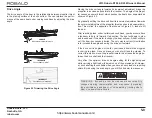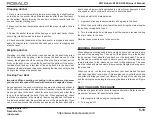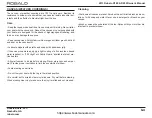
2013 Robalo R180 & R200 Owner’s Manual
Robalo Boats, LLC
Nashville, GA
robalo.com
5-9
Stopping Your Boat
A boat has no brakes. Stop the boat by allowing it to slow down to less
than 5 miles per hour and then putting the engine in reverse. Slowly in-
creasing reverse power will allow you to stop the boat in a short distance.
Remember that a boat does not respond to steering in reverse as well as
it does when going forward.
WA R N IN G :
C heck
behind
you
before
com ing
O FF
plane.
M any
a ccid e n ts
o ccu r
e a ch
ye a r
a s
a
re su lt
o f
a
d rive r
co m in g
o ff
plane
w hile
being
follow ed
by
a
boat
that
is
unable
to
slow
dow n
in
tim e
to
avoid
collision.
Additional Underway Information
• Always be aware of local laws on noise limits. Noise means engine
noise, radio noise or even yelling by people on your boat. Good seaman-
ship demands that you operate your boat quietly so as not to infringe on
the rights of others.
• You are responsible for any damage or injury caused by your boat’s
wake. Observe no wake speed zone warnings. Operate your boat with
regard for the safety of other boats and people in your boating area.
• Keep your engine well tuned to decrease exhaust hydrocarbon emis-
sions that pollute the air and water.
ANCHORING YOUR BOAT
Anchoring is necessary if you stop for recreation or an emergency. Prac-
tice anchoring techniques to make sure you know what to do when an
emergency occurs. The size and weight of your boat govern the weight of
the anchor and the diameter of the anchor line. Your Robalo dealer can
help you select the proper anchoring equipment for your boat.
Use a burying anchor, such as a Danforth or plow anchor, which grips into
the bottom and holds your boat secure. Holding power should be more
important than weight. For anchoring in relatively quiet waters, you can
use a mushroom anchor as an alternative.
The length of the anchor line should be six to eight times the depth of the
water to ensure that the anchor bites into the bottom. The bottom end of
the anchor line should be galvanized chain which holds up well as the
line moves back and forth on the bottom. The rest of the line should be
nylon anchor line which stretches to soften the impact of wind and waves
on your boat.
Following are general guidelines for anchoring your boat:
• Secure the anchor line to the bow eye or deck cleat. Do not tie line to
hardware not designed to support this stress.
W A R N IN G :
K e e p
a n c h o r
s e c u re
w h ile
u n d e rw a y
to
p re ve n t
d a m a g e
o r
in ju ry
if
b o a t’s
a ttitu d e
ch a n g e s
su d d e n ly.
If
yo u r
boat
has
a
pow er
w inch,
do
not
use
it
as
the
prim ary
source
for
securing
anchor
or
anchor
line.
S ee
the
pow er
w inch
instruction
m anual
for
details
about
proper
operation
and
m aintenance.
• Use two or more anchors if anchoring overnight or extended periods
of time. Otherwise, make sure your boat has enough space to swing full
circle in case of shifting winds.
• Keep the anchor and line in an area where it will be readily available in
an emergency.
https://www.boat-manuals.com/
















































